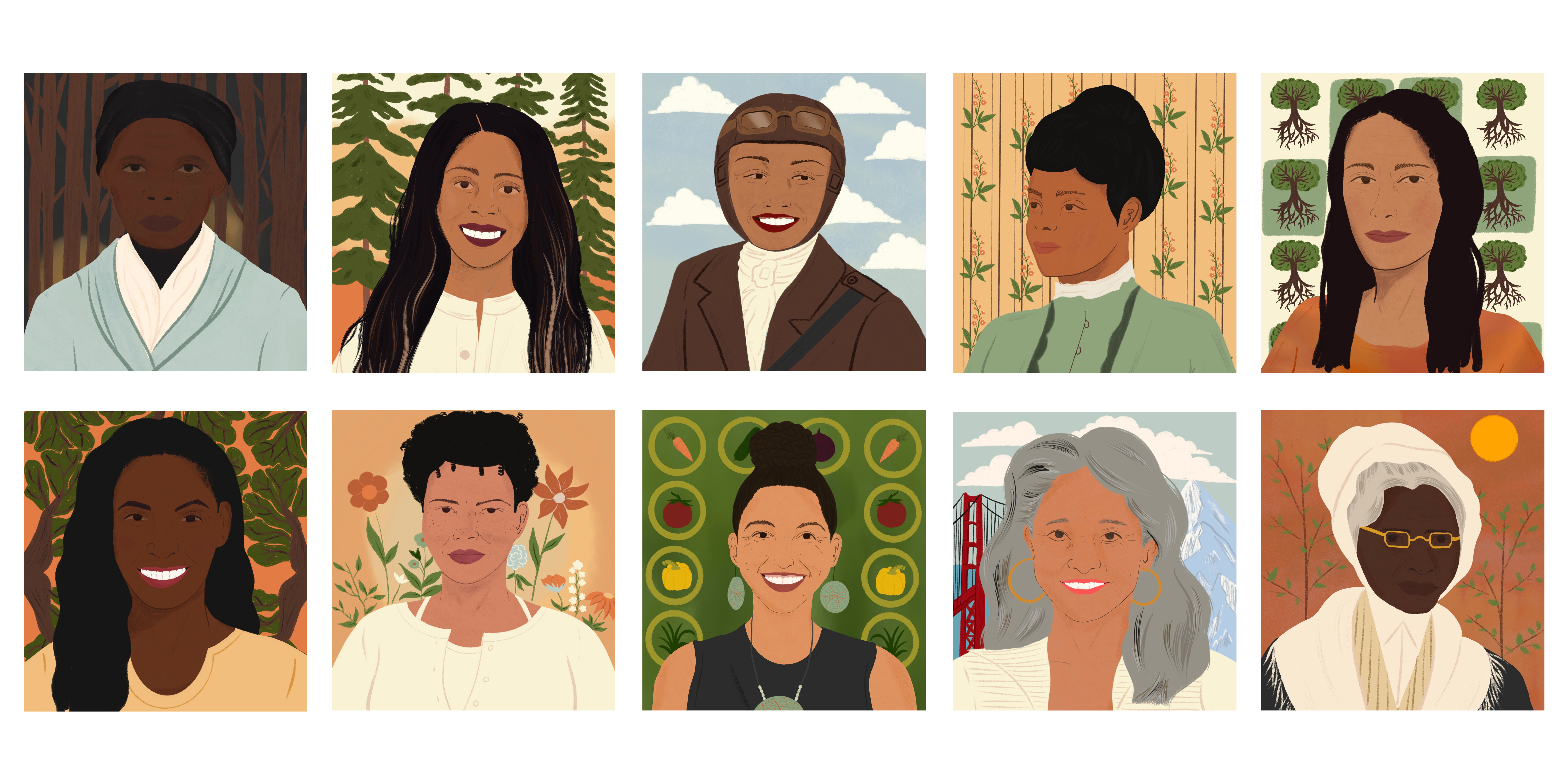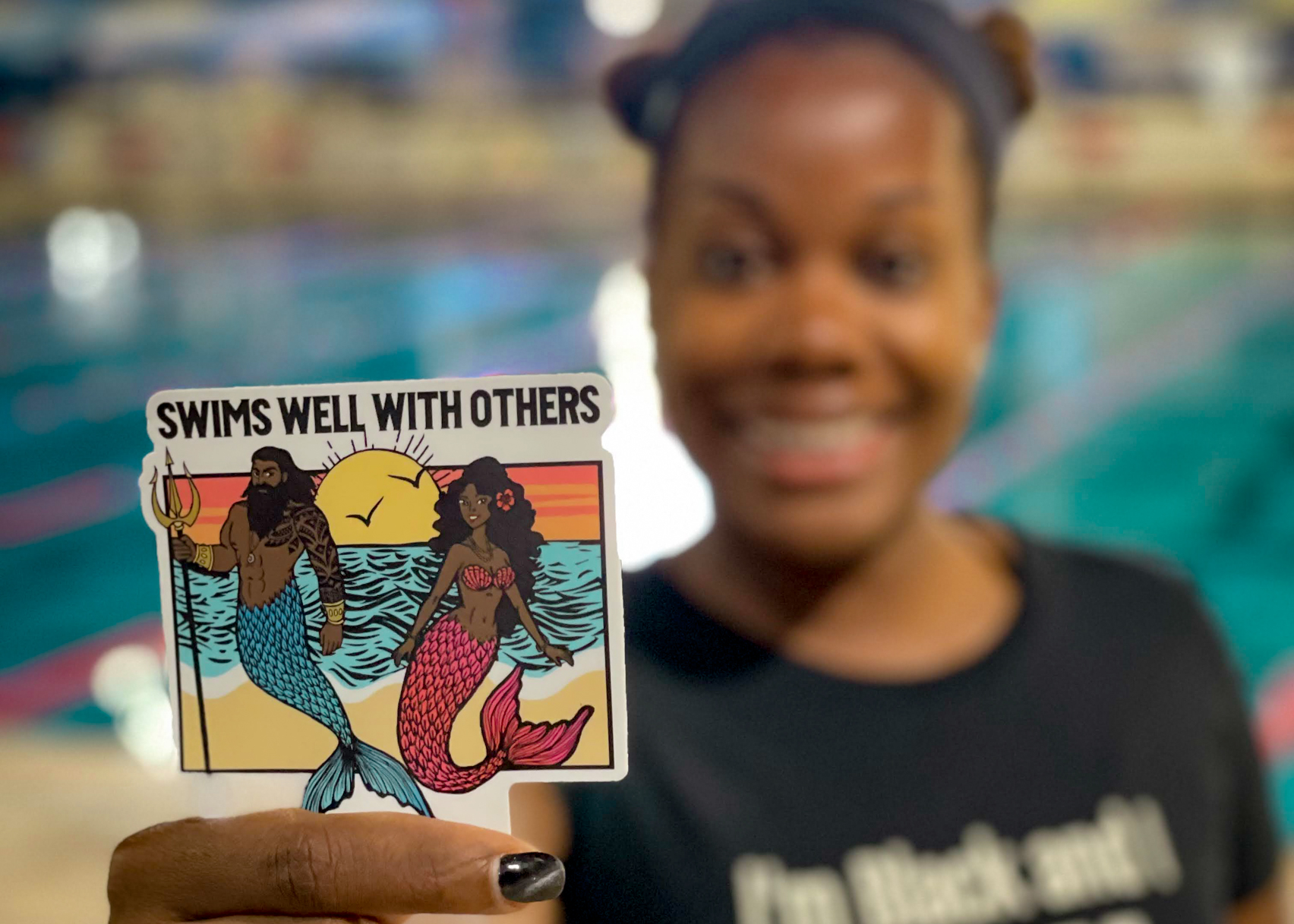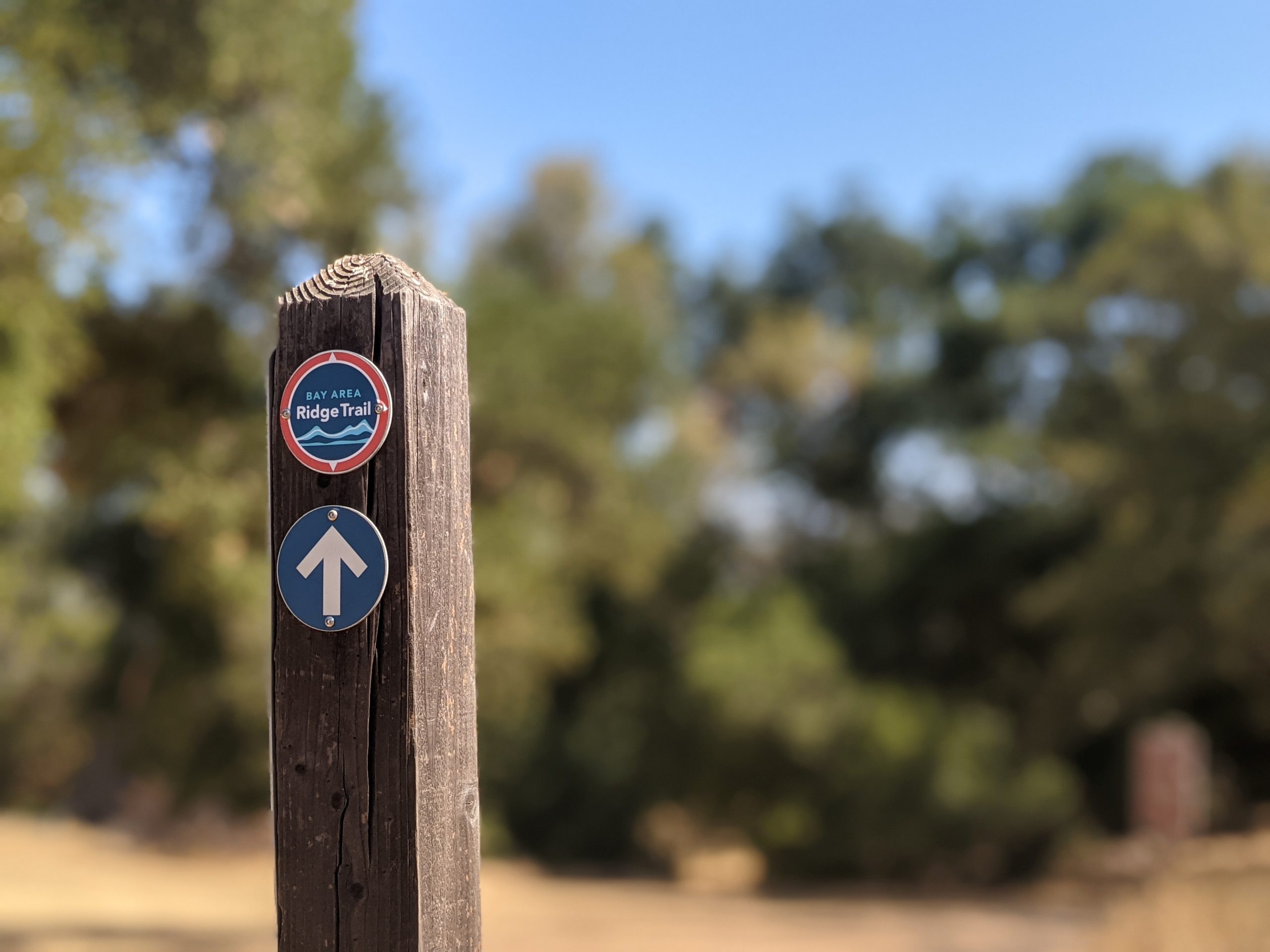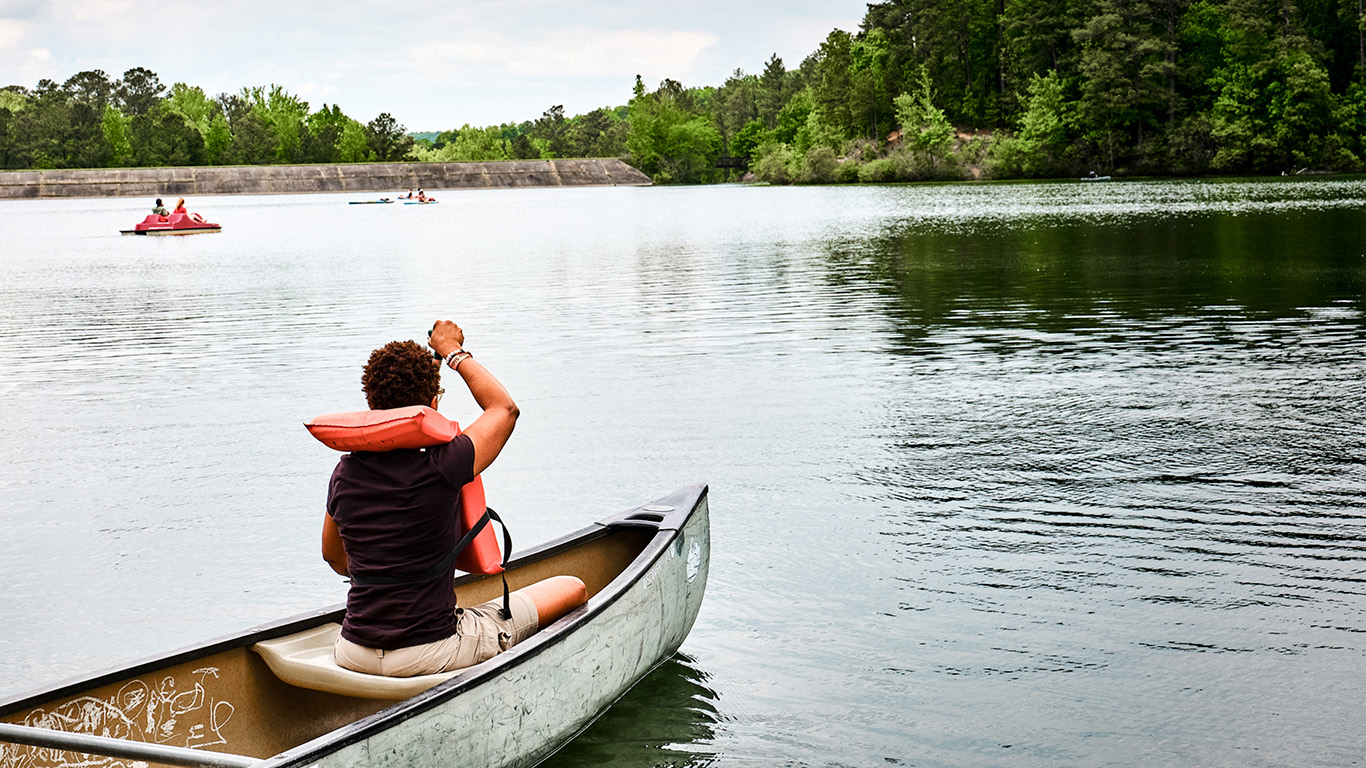10 Black outdoorswomen who nourish our ‘Nature Swagger’
Some are the “first” in their outdoor odysseys. All are fearless in their historical nature experiences. For Women’s History Month 2023, Outdoor Afro wanted to acknowledge a few female inspirations and contributors of new book “Nature Swagger” by Rue Mapp in collaboration with American publisher Chronicle Books. As founder and CEO of Outdoor Afro, Mapp has transformed her kitchen table blog into a now national not-for-profit organization that celebrates and inspires Black connections and leadership in nature. Since this year’s monthlong theme is “Celebrating Women Who Tell Our Stories,” Mapp’s newest coffee table read sets a natural scene to appreciate those wilderness women who have – and still are – strengthening relationships to land, wildlife, and waterways.
“Nature Swagger” published November 2022 and documents original stories, photographs, and spotlights from Outdoor Afro volunteer leaders, related organizations, and prominent Black outdoor influencers Mapp has collaborated with personally and professionally throughout her outdoor industry adventures. “It was important to tell the story of the people and their special places that not only informed my own connection to nature,” said Mapp, “but of the many people I have had the pleasure of getting to know over the past decade.” The book elevates the fact that being Black isn’t a singular experience. Instead, reflective of region, age, personal history, and more, said Mapp. “‘Nature Swagger’ includes stories of individuals who anyone can relate to or who might remind us of family and friends. I want readers to be inspired and see nature from many perspectives, thinking broadly of what connections to the outdoors can look like for anyone.”
HARRIET TUBMAN: Tying into Outdoor Afro’s Black History Month 2023 coverage about the Underground Railroad, Tubman became one of the most revered conductors of the well-structured network. The nature navigator guided freedom efforts for hundreds of enslaved men and women in the American South. Yet, her reliance on the outdoors goes deeper than ushering others through dangerous forests. Tubman became a student of those around her – as a former enslaved woman herself. She listened intently to the local maritime workers to gain knowledge about constellations and how these sources could silently map routes to “stations” or safe houses. She was also a naturalist. Her keen desire to seek freedom was her driving force to understand the medicinal properties that various plant species held. She healed wounded Black soldiers – often in the middle of the night – as they fought their way to the other side of enslavement. Today, we honor Tubman not just for her work in helping forge the path to freedom for the ancestors but her interconnectedness outlook to the benefits of nature.

BESSIE COLEMAN: This aviation pioneer soared into history books as the first Black woman to earn a pilot’s license in 1921 – and the first Black woman to fly publicly in 1922. Interestingly in the early 20th century, most aircraft featured an open-air design, which provided instant access to the elements. Bessie Coleman once said, “The air is the only place free from prejudices.” Coleman’s history-making journey was far from easy. The Texan-born and Langston University-educated aviatrix was determined to fly despite the naysayers. When no U.S. flight instructor wanted to teach her, Coleman put herself through language school to first learn French then travel to France. It was there that she earned a pilot’s license. Her contributions to aviation landed her into the National Aviation Hall of Fame in 2006. To start 2023, Mattel honored her with a commemorative doll through its Barbie Inspiring Women Series. Mapp just became a 2023 Bessie Awards finalist as part of global lifestyle brand Wanderful’s annual summit recognizing women impacting the travel industry.

IDA B. WELLS: After losing both parents to yellow fever at age 16, Ida B. Wells’ tenacious spirit safeguarded her and her surviving siblings to live decent lives. From working as a school teacher to becoming a newspaper owner, she always centered Black communities. Credited as one of the main activists and voices during the Women’s Suffrage Movement, Wells made it her business to ensure women were treated fairly. Especially Black women. It even led to her forming Chicago’s Alpha Suffrage Club in 1913. The organization was the main catalyst to pass the Illinois Anti-Suffrage Act. The skilled journalist and researcher fearlessly covered the American South and its lynching culture of Black people. She became a Pulitzer Prize winner 158 years after her death, earning the highest national honor in print journalism "for her outstanding and courageous reporting on the horrific and vicious violence against African Americans during the era of lynching."

SOJOURNER TRUTH: Born Isabella Baumfree, Sojourner Truth was known to many as someone who captured the horrors of enslavement through her profound speech. Her real talent and claim to fame: photography. Her photographs – called carte de visite at the time – depicted everything from her storied life to mid-1800 political leaders and figures. Her photos gained popularity almost instantly. She used the art form to support herself, but the small images also became instrumental in helping to end slavery. Her photos were published in newspapers nationwide to help spread word of slavery’s grisly scenes. Truth’s work sparked deeper conversations and movements around the times. It seemed as though she invented a type of currency that financed her activism. She once said about her cause work, “I sell the shadow to support the substance.” More recently, her name has come into discussions around headshot placement onto one of the U.S. dollar bills. However, that American topic remains a stalemate.

 RUE MAPP: An awarded leader, a public lands champion, and a motivational speaker, Rue Mapp started Outdoor Afro as a kitchen table blog and social enterprise in 2009. She incorporated it as a 501(c)(3) organization in 2015. Today, Outdoor Afro includes more than 100 volunteer leaders across the United States who guide a participation network of more than 60,000 people in nature. The modern-day outdoorswoman from Oakland, California, originated Outdoor Afro to celebrate and inspire Black connections and leadership in nature. During the past 14 years, the not-for-profit outfit has changed public perceptions of Black people and Black communities only having pain-and-peril narratives. Instead, Outdoor Afro centers the culture’s Black joy in nature moments. “Nature Swagger” is a continuation of Mapp’s community work in the outdoors by highlighting various storytelling forms and age groups. Along with publishing “Nature Swagger” in 2022, she co-created a hike collection with REI Co-op through her for-profit enterprise Outdoor Afro, Inc. to help solve unmet needs in outdoor apparel. She has earned international attention from media like Oprah Winfrey, The New York Times, Good Morning America, Forbes, and Netflix’s popular series MeatEater with Steven Rinella.
RUE MAPP: An awarded leader, a public lands champion, and a motivational speaker, Rue Mapp started Outdoor Afro as a kitchen table blog and social enterprise in 2009. She incorporated it as a 501(c)(3) organization in 2015. Today, Outdoor Afro includes more than 100 volunteer leaders across the United States who guide a participation network of more than 60,000 people in nature. The modern-day outdoorswoman from Oakland, California, originated Outdoor Afro to celebrate and inspire Black connections and leadership in nature. During the past 14 years, the not-for-profit outfit has changed public perceptions of Black people and Black communities only having pain-and-peril narratives. Instead, Outdoor Afro centers the culture’s Black joy in nature moments. “Nature Swagger” is a continuation of Mapp’s community work in the outdoors by highlighting various storytelling forms and age groups. Along with publishing “Nature Swagger” in 2022, she co-created a hike collection with REI Co-op through her for-profit enterprise Outdoor Afro, Inc. to help solve unmet needs in outdoor apparel. She has earned international attention from media like Oprah Winfrey, The New York Times, Good Morning America, Forbes, and Netflix’s popular series MeatEater with Steven Rinella.

DR. CAROLYN FINNEY: She initially pursued acting as a career choice but was transformed by a five-year backpacking journey through Africa and Asia before she planted new roots in Nepal for a few years. The experience changed Dr. Carolyn Finney’s life so much that she went back to school to earn both bachelor’s and master’s degrees in gender and environmental issues in Kenya and Nepal. A few years later, the now author, storytell, and cultural geographer earned a doctorate to address the inequalities and lack of diversity within environmental organizations and institutions. She often explores why Black people and Black communities are underrepresented in nature, environmental, and outdoor recreation discourse. Her 2014 book “Black Faces, White Spaces” examines this subject. She uses her artistic voice and presence to illustrate these courageous conversations with global audiences.

 ANGELOU EZEILO: With good grace, she’s considered an industry disrupter who has spent the past 13 years forging partnerships and creating powerful programming to diversify outdoor-focused organizations and companies. Angelou Ezeilo boldly speaks her truth to break barriers that prevent Black people, Black communities, and Black experiences from inclusion into nature and outdoor industry storylines. Working a lot with young people, she has dedicated her talents to connecting them to conservation-related careers and opportunities. What she started as simply conservation lessons in Gwinnett County, Georgia, elementary schools has now grown into the Greening Youth Foundation. Founded in 2007, the foundation bridges the gap between underrepresented youth and young adults, creating space for newer generations to thrive in state and federal land management sectors.
ANGELOU EZEILO: With good grace, she’s considered an industry disrupter who has spent the past 13 years forging partnerships and creating powerful programming to diversify outdoor-focused organizations and companies. Angelou Ezeilo boldly speaks her truth to break barriers that prevent Black people, Black communities, and Black experiences from inclusion into nature and outdoor industry storylines. Working a lot with young people, she has dedicated her talents to connecting them to conservation-related careers and opportunities. What she started as simply conservation lessons in Gwinnett County, Georgia, elementary schools has now grown into the Greening Youth Foundation. Founded in 2007, the foundation bridges the gap between underrepresented youth and young adults, creating space for newer generations to thrive in state and federal land management sectors.

AKIIMA PRICE: The creative thinker links change-making people, places, and programs with underserved communities. A Washington, D.C., native, Akiima Price is a nationally respected influencer who works at the intersection of social and environmental issues and the relationship between nature and community well-being. She co-founded the Friends of Anacostia Park, an urban national park in D.C. The innovative model focuses on park restoration, nature-based human development, and workforce development in highly stressed communities surrounding the park. Previously serving as an interpretation ranger for the National Park Service at Lake Mead Recreation Area in Colorado, she has cultivated 30 years of experience in cutting-edge best practices around trauma-informed environmentalism. “As a child,” she said, “we moved from an apartment to a suburban townhouse where people were trying to move up and out of public housing. There was a dirt field behind our house, and we played in that dirt field and a sewer tunnel. We saw foam but didn’t know it was waste. We played and caught butterflies.” Today, that landfill is gone. Akiima uses that experience as a reminder and reconnection tool to strengthen community relationships to local parks.

LEAH PENNIMAN: A 2019 James Beard Foundation Leadership Award recipient, Leah Penniman is one of many innovative leaders of the Black farming movement. Although Black agricultural practices are centuries old, the obstacles and racism that Black farmers still face are oftentimes overwhelming to juggle in a now digital economy. Penniman co-founded Soul Fire Farm in New York, which operates in the food justice space within America’s food system. With the goal of reconnecting Black people and Black communities to ancestral lands, Pinniman helps develop programs that train Black farmer cohorts – both domestic and international – on the importance of food equity. Penniman’s work has reached Ghana, Haiti, and Mexico. She has gained support through the Fulbright Program’s Soros Racial Justice Fellowship and even became a recipient of the Pritzker Environmental Genius Award. She penned powerful books on the topic of Black farming, including the 2018 release of “Farming While Black: Soul Fire Farm’s Practical Guide to Liberation on the Land.”

ELAINE LEE: One of the original definitions of a travel influencer, Elaine Lee is a globetrotter, travel writer, and media maven. For decades, her storytelling experiences have taken readers inside destination diaries and colorful articles about Black travel trends, women’s travel issues, solo travel, budget travel, travel planning, and health. In 1997, Lee published classic trek keepsake, “Go Girl: The Black Woman’s Book of Travel and Adventure.” Her book became a recommended read by Essence, Black Enterprise, and Upscale magazines. She has been featured on popular national and local radio and TV shows, including the Travel Channel. Lee also developed the Bay Area’s first travel radio show with travel writing colleague Pamela Michaels in 1999. Her worldwide trips have totaled 61 countries, traveling solo in 1992 and 2004. The “wander” woman continues to fly. More outdoor titles this bibliophile holds: sailor, cyclist, skier, and long-distance swimmer. In these new media times, she shares her travel writing and provides international travel advice through online forum Ugogurl.com.

*Illustrations by Dajah Callen
Nature Champs: CLIF® Athlete Venus Williams, Outdoor Afro
Consider Virginia Key Beach as the response to white-only swimming pools and water recreation. In the middle of the 20th century, this Miami vacation destination for Black people granted access to boating, fishing, surfing, swimming, and beachside lounging. A way of life for generations of Black nature enthusiasts and Black wealth to thrive – even while segregation tormented the country. Outdoor Afro revisited this historical landmark summer 2022 with partner CLIF BAR® and CLIF® Athlete Venus Williams to reflect on Black joy and healing in nature-rich places.
“What an honor to not only share the day with Venus but with our Founder and CEO Rue Mapp,” said Outdoor Afro volunteer leader Sierra Taliaferro with binoculars ready. “I wanted to do my best to provide a memorable experience in my backyard of Miami." Joined by fellow volunteer leader Michele Nedrick, Taliaferro led Outdoor Afro community participants, Mapp, and the tennis star through the beach’s nature trails and cultural history. Taliaferro helped the group identify native flora and fauna in between genuine conversations to learn more about each other.
A Miami transplant, Taliaferro spends most weekends exploring area routes. Like the Outdoor Afro activities she hosts monthly, this partnership experience allowed both Taliaferro and Nedrick to introduce new CLIF BAR® and Outdoor Afro staff to local stories and species of the beach. Decades of it. “Virginia Key Beach is not only historically Black,” Taliaferro said, “but it’s monumental to our sometimes forgotten history.” The recreational site became a cherished safe space in the 1940s onward for Black beachgoers of the states to Black immigrants of South America, Cuba, and various Caribbean islands.

It wasn’t until 1982 that the city of Miami closed the beach because of “rising maintenance costs.” After a decades-long fight by the Virginia Key Beach Civil Rights Task Force, the beach landed on the National Register of Historic Places in 2002. It reopened to the public in February 2008. An ideal spot for Nedrick and Taliaferro to host Outdoor Afro network activities yearlong that naturally strengthen the neighborhood’s connection to its land, water, and wildlife. In rhythm with typical network hikes, Nedrick and Taliaferro started the day with Outdoor Afro’s signature opening circle of introductions. Then, their educational and transformative tour meandered through sandy tracks and prickly-ash plants.
Occasionally, migrating birds and zebra longwing butterflies fluttered by the group as insect sounds amplified the ambience of the tropical wilderness experience. A fervent birder, Taliaferro often used her “field glasses” to identify native feathered friends for the day’s company. Since the beach is right on the coast, water birds were the easiest to pinpoint: white ibises, double-crested cormorants, and black-crowned night herons. “I often emphasize to beginner birders that birding is unconventional,” said Taliaferro. “You literally can do it anywhere. Even from your backyard.”
What led to this moment of Outdoor Afro volunteer leaders – sharing their expertise about this place of purpose for Black people – and CLIF BAR® goes back nearly a decade ago. CLIF BAR® and Outdoor Afro have been partners since the network became a national not-for-profit organization in 2015. Continuing to grow the partnership, CLIF BAR® created CLIF CORPS. This initiative is CLIF’s employee-led community service program where CLIF® Athletes donate time and resources to support nonprofits that make the spaces they live and play in more accessible and inclusive.

Williams serves as a CLIF® Athlete and has been a fan of Outdoor Afro for some time now. The perfect recipe to have a Black joy (and Black history) moment in nature: “I am honored to be part of this new chapter of CLIF CORPS and to support Outdoor Afro’s work to show greater representation in the outdoor community,” said Williams. “Together we will make a meaningful impact to reconnect Black communities with the outdoors and sports through education, recreation, and conservation.” The CLIF CORPS partnership features a series of ongoing giving and service amplifications with community groups like the Women’s Sports Foundation and National Parks Service. The goal is to provide opportunities for people across the United States to participate in activities otherwise deemed inaccessible or unwelcoming for social, emotional, or economic reasons.
Throughout this year, Outdoor Afro volunteer leaders will guide CLIF-supported outdoor experiences across its four regions: Midwest, Northeast, South, and West. Activities range from biking, kayaking, and hiking. "A recent study led by Penn State found that 1 in 5 Americans have taken on a new outdoor hobby since the beginning of the COVID-19 pandemic. However, many Americans are unable to experience these benefits due to inequities in access to the outdoors and sports,” said Jodi Olson, Vice President of Brands at CLIF BAR®. “That’s why we are collaborating with Venus Williams and Outdoor Afro, two of our long-time partners, to enact change and break down systemic barriers, creating more diverse and inclusive activities for our communities.”
Williams and Outdoor Afro took a beach walk. A few community participants showed off their driftwood tightroping abilities. When everyone made their way back to the initial opening circle location, the space created a new appreciation for Black contributions that developed the beach. The seaside stroll reinforced the everyday work Outdoor Afro does to celebrate and inspire Black connections and leadership in nature. Taliaferro wrapped up the evening by sharing that “nature allows us to see not only the surrounding beauty, but also the beauty in ourselves. Nature is truly a reflection of us.”

The water is ours too — always has been
Like most instances in American history, the pioneering roles Black people have held in water-related industries has rarely been acknowledged, documented, or celebrated. For decades, there has been an ongoing myth that Black people — mostly in the Americas — have no or limited relationships with water. Outdoor Afro volunteer leader Hillary Van Dyke has been instrumental in not only uncovering our hidden history in the St. Pete and Tampa, Florida, areas, but she is also taking charge to ensure her local community strengthens its connection to water, like our ancestors did. Van Dyke, a Southern-based historian, has spent time conducting research on the Black men who helped establish and ultimately make the area’s sponge diving business what it is today.
“Sponge diving is a major industry in Tarpon Springs, Florida,” Van Dyke said. “It has now expanded into tourism where tour operators take people out on boats to see how the sponges were once harvested. However, when on these tours, the only pictures or faces you see are those of the Greek and/or white men who later built the industry.” The sponge used in modern times is now a synthetic material. Back in the day, Black divers helped collect sponge. Practical for cleaning and scrubbing purposes. In addition to maintaining personal hygiene, the sponge helped with filtering water and padding helmets.
It wasn’t until a 2008 Pinellas County survey released — the county in which Tarpon Springs (the “Sponge Capital of the World”) is located — that details on Bahamian male swimmers being the driving force of the industry were discovered. “The actual industry was built by these Black men,” said Van Dyke. “When the sponge fields were discovered in the area in the late 1800s, Bahamian divers were recruited and brought to the area to work in the businesses. But none of that is shared publicly or during the tours.”
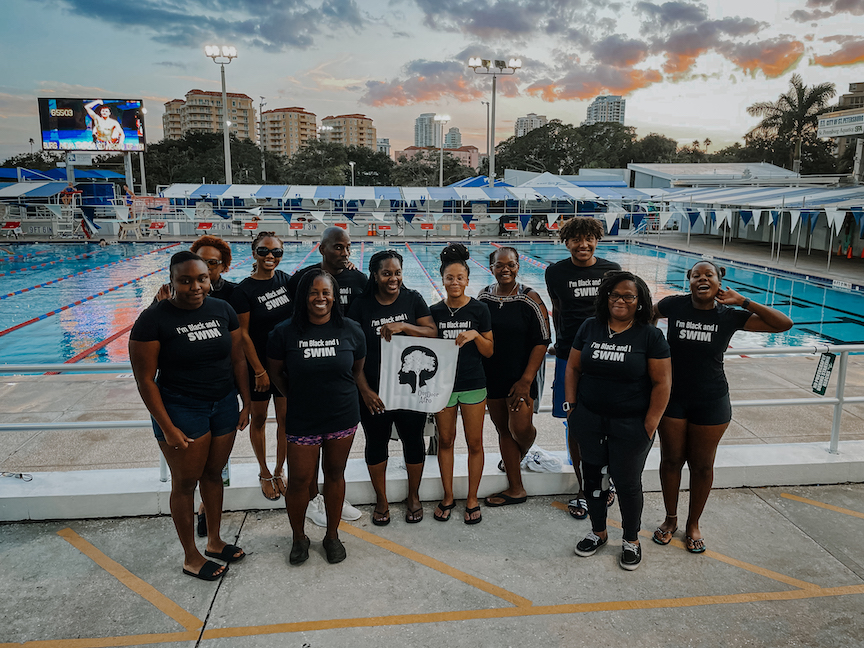
According to the 2008 survey, boats from Key West made regular trips to the sponge beds and returned with rich harvests. An influx of Bahamian sponge fishermen established posts along the Anclote River. This led to more than 120 boats operating and new businesses springing up around the sponge fields at the helm of the Black divers. In 1905, Greek immigrants began arriving in Tarpon Springs after a Greek businessman working in the sponge diving industry made people in his homeland aware of the success of the industry.
Within one year, some 1,500 Greeks had come to Tarpon Springs, joining with the Bahamian residents to support a thriving industry, the survey explains. By 1908, sponge harvesting was one of the largest industries in Florida. Tarpon Springs as a major base of operations. The irony: “The Greek divers are described as helmet divers. They wore complex diving suits to harvest the sponges,” Van Dyke said. “This is also a major part of what is highlighted during the tours being operated today. However, the Black Bahamian men were all free divers, using no equipment at all to go under the water.”

Through her leadership role as an Outdoor Afro volunteer, Van Dyke wanted to correct local history. As part of her weekend activities with community participants, she asked participants if they wanted to take adult swim and scuba diving lessons in the area. They did. “I have close connections with the city and wanted to be able to offer this to adults who never learned to swim,” the 2021 Outdoor Afro “Leader of the Year” said. “It’s very courageous of any adult to make the decision to learn to swim later in life. There are often deep-rooted traumas associated with our reasons as Black people for not learning early in life. So, I know it takes a lot for them to join our classes.”
LEARN ABOUT OUTDOOR AFRO MAKING WAVES PROGRAM
While participants take their swim lessons, Van Dyke shares the history and impact the Black divers had on Tarpon County. Reconnecting them to the group’s generational relationships with water. “They always find it very intriguing, especially knowing that none of this is being shared elsewhere.” Van Dyke dives deeper into history by mentioning that in the mid-1950s local officials received funding to build a ‘Negro-only’ beach. A move that happened after conflict of trying to integrate the area’s segregated beach arose. However, rather than using the funds to do so, officials instead built North Shore Pool, which was for white swimmers only.
A song and dance Black communities have seen and experienced firsthand for generations. From the famed Inkwell in Oaks Bluff, Massachusetts to the countless ‘swim-ins’ that took place across the South — longstanding evidence Black people and Black communities have a deep love of and natural links to waterways. Van Dyke serves as a continuation of Outdoor Afro’s mission to inspire and celebrate Black connections and leadership in nature. Changing the narrative that Black people “don’t do water.”
7 Bay Area Ridge Trail routes to summer trip plan
Planning a trip to the Bay Area with Outdoor Afro is a guaranteed outdoor adventure. Volunteer leaders guide some of the most enriching events to establish new relationships with natural West Coast wonders. Mountain hikes. Valley bike rides. Beach games. Public land nature journaling. You name it, volunteers have probably guided it. So here’s another adventure to anticipate exploring with the network: the Bay Area Ridge Trail.
Spanning 400 miles, this multicity network of trails offers everything from camping to flower spotting. It winds through San Francisco, Marin, Oakland, Napa, Sonoma, San Jose, the Peninsula, Berkeley, and Fremont. Multi-use pathways meander between the area's North and South Bay. The idea to develop such a comprehensive trail spawned from a group of outdoor enthusiasts who envisioned an extended option for Bay Area residents, providing epic routes for those itching to discover more of nature from their backyards.
The trail opened in 1989. As of November 2021, 400 miles have been dedicated for public recreational use with another 150 miles opening in the coming years for the same purpose. Once the full 550 miles complete, residents and tourists will have continuous access to more than 75 parks and open spaces. Visitors can go by foot and even horseback through some of the Bay Area’s most iconic and tranquil naturescapes and backdrops. Of course, mapping out such a massive route can become challenging, however the trail’s website offers an easy-to-use system — the Ridge Trail Circumnavigation.
Plan everything from campsite locations and multi-day itineraries to determining the closest parking lots and best locations for a scenic picnic with gal (or guy) pals. Although there are still some unfinished parts to the trail, adventurers can take advantage of the trail’s two long, uninterrupted stretches that are currently open. On the Western Ridge: an 80-mile stretch from Northern Marin to Highway 92. On the Eastern Ridge: a 43-mile stretch from El Sobrante to Union City. View the full database of trail maps to organize summer trips. Fun options for future Outdoor Afro Meetups the network is considering as well. So include these starter locations into this year’s Bay Area travel plans, whether an independent day trip or longer excursion with family and friends:
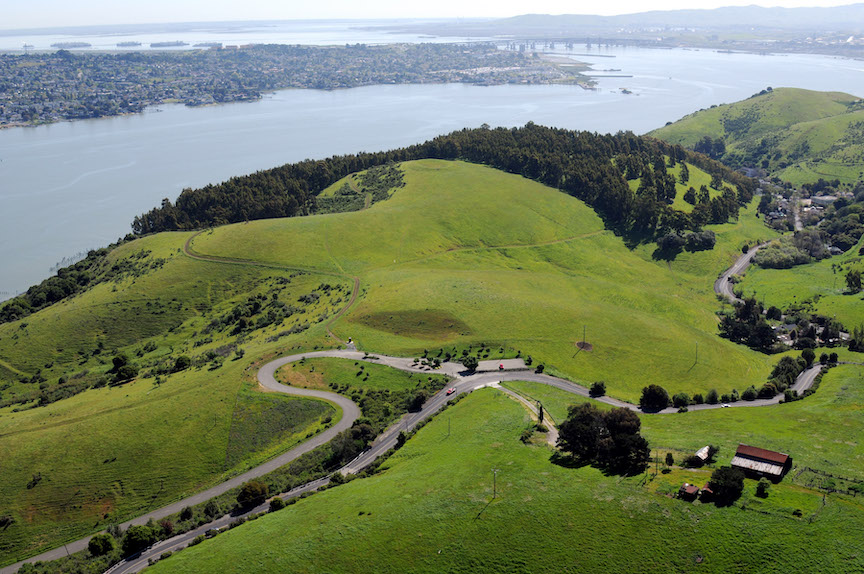
Presidio to Marin Headlands
Distance: 1.9 miles | Difficulty: Easy
The star to this stretch of trail is none other than San Francisco’s Golden Gate Bridge. One of the less strenuous paths, this short walk also is accessible by wheelchair. As with any bridge, wind conditions are unpredictable, so be sure to carry an extra layer of clothing (scarves or pullovers) to confront extra breezy days.
Mount Tamalpais State Park/Bolinas Ridge
Distance: 6.4 miles | Difficulty: Moderate
For those who enjoy smartphone-worthy landscapes, this is the ideal trail section. From blooming wildflowers to ocean view lookouts along each step, this hike may be a little more demanding, but the vista will certainly help keep the trip on scenic course.
Jack London State Park and East Slope Sonoma Mountain
Distance: 5.5 miles | Difficulty: Hard
Challenge seekers: This one is definitely the one. So, bring it. The trail is located within the historic Jack London State Park. During the journey, expect to go through a rather dense forest. The perk while making it through this woodland is calming streams flowing nearby. Reach the highest point of the mountain’s ridge, and scenery typically found in global magazines of Valley of the Moon and the Bay are end results.
Table Rock to Palisades Spur
Distance: 6 miles | Difficulty: Hard
Ever pondered what it’s truly like to ascend to the highest point of the Bay Area? Now is the time to put action behind the thought. It’s often recommended to try this hike between April and June, because that’s also when wildflowers endemic to the area come out to play. See if you can spot the Southern Oregon buttercup, the Henderson’s fawn lily, or the dwarf woolly meadowfoam. To be clear: This trail requires full hydration, so pack enough fluids to keep moving steadily.
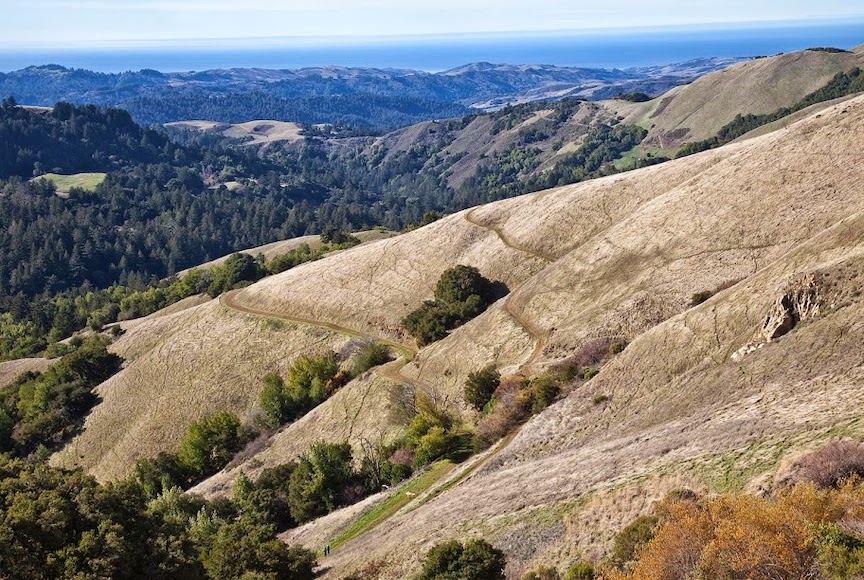
Coyote Lake to Harvey Bear Ranch Park
Distance: 5.6 miles | Difficulty: Moderate
This stretch is picnic perfect. Unplug for a couple of hours next to Coyote Lake, which is a popular feeding area for wild bird species like blue herron, red-necked grebe, and ring-necked ducks. Camp around this popular waterway. Easily bring a backpack. Pitch a tent. Plunge into local lake life. Keep in mind there’s very little shade along the trail, so pack sunscreen, a hat, and sunglasses if possible.
Carquinez Straight Bike Loop
Distance: 24 miles | Difficulty: Difficult
For Bay Area mountain bike riders, this mix of paved roads and pathways connects the Carquinez Straight through a 24-mile loop. Along the way, take in rarely seen cityscapes of the Bay. When it’s break time, there are plenty of eateries and cafés along the route to refuel or restock on snacks and knick knacks.
Mount Madonna County Park
Distance: 3.5 miles | Difficulty: Difficult
This route is entirely uphill, so prepare mentally and physically before attempting. Start from the Sprig Recreational Area trailhead to climb and climb and climb. Pass by boulder-laced grasslands before finishing in a redwood canyon. It’s an estimated 1,150-foot slope, so good luck!
Boating Season 2022: 5 water safety tips to know
Warm weather means more Sunday fundays on a pontoon boat or pulling out family kayaks and canoes to cruise local rivers. However you prefer to spendtime on the water during summer 2022, safety first. Always! In preparation for the National Safe Boating Council’s National Safe Boating Week (May 21 through May 27), Outdoor Afro wants to remind you of the dos and don’ts to boating season adventures.
“The best boating experience is safe boating,” said Yvonne Pentz, communications director of the National Safe Boating Council, a nonprofit dedicated to helping create a safe boating experience for all boaters and the lead organization of the Safe Boating Campaign. “Have fun on the water, make memories with your family and friends – all while boating responsibly.” That said, here are five best practices to help you stay safe while creating water moments:
LIFEJACKETS. LIFEJACKETS. LIFEJACKETS. Lifejackets. It doesn’t matter if you’re a beginner or veteran swimmer, wearing a lifejacket (or at the very least, having them nearby) should always be at the top of your safety list. The council recommends having life jackets on children under the age of 13 while swimming or during other activities on open water. This also holds true for adults while boating.
ENGINE CUT-OFF DEVICE. Things happen. Better to be safe than sorry. Emergencies can arise on the water at any time. Whether you drop something into the water, or worse, a person goes overboard. An engine cut-off device — often worn around your wrist or attached to your lifejacket — ensures the boat’s engine will shut off instantly.
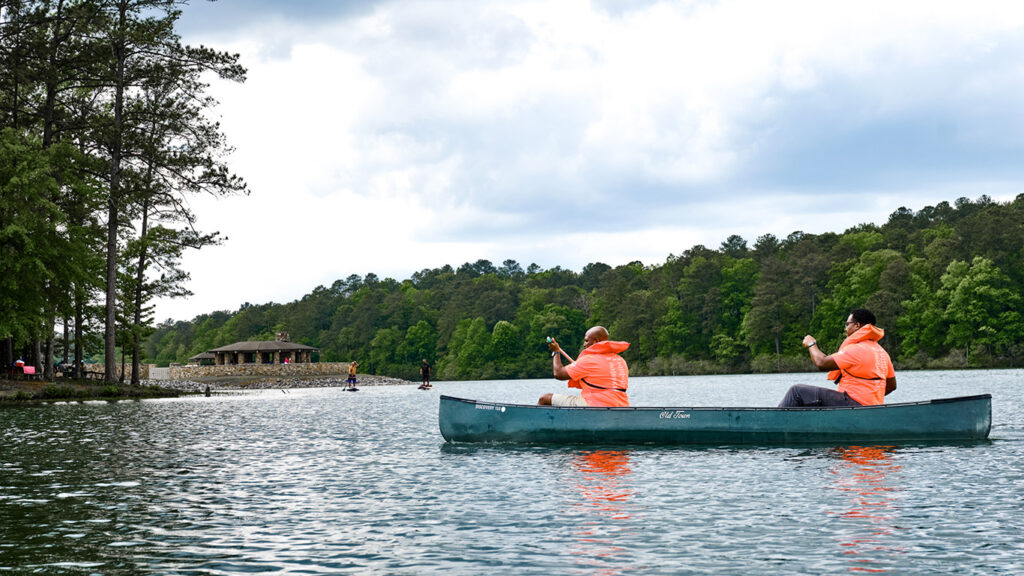
DON'T BOOZE AND BOAT. Yes, a BUI is most definitely a thing. So, no “Boating Under The Influence.” According to the council, BUIs accounts for one-third of all recreational boating fatalities. We all want to have fun on the water, but just like with a car, getting behind the wheel while under the influence is a big no-no. Alcohol impacts vision, balance, coordination, and judgment. Increasing the likelihood of accidents. Know that it’s illegal to operate a watercraft under the influence of both drugs and alcohol in every state. The Coast Guard enforces a federal law that provides BUIs, too. Including all boats: canoes, rowboats and ships.
BE AWARE OF CARBON MONOXIDE EXPOSURE. Most people don’t associate boats with producing carbon monoxide, but they certainly do. Because it’s an odorless and colorless gas, you likely won’t know if it’s being emitted. The best thing to do to remain safe on the water is to avoid swimming anywhere near the rear of a motorized vessel, or sitting along the swim deck/platform while the boat motor is running.
HAVE A PLAN, WAYS TO COMMUNICATE BEYOND THE BOAT. Again, you never know what could happen during your outdoor water journeys. It’s always great practice to let someone back ashore know your route plan as well as how long you plan to be on the water. You’ll also want to make sure any communication devices like phones, emergency locator beacons, or walkie-talkies are charged, have a signal, and work properly.

